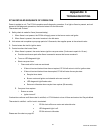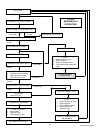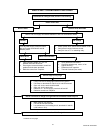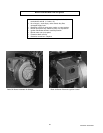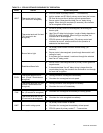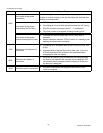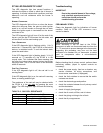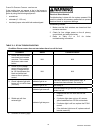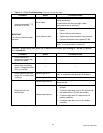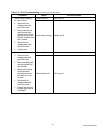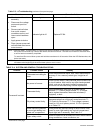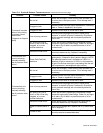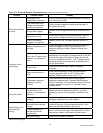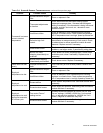
29733 R2 06/01/2003
38
T
ABLE C-4: SYSTEM & GENERAL TROUBLESHOOTING, continued from previous page
Problem Possible Cause Remedy
Electrodes out of
adjustment or defective.
Check electrode settings. check electrodes for dirt build-
up or cracks in porcelain.
Poor transformer high
voltage connections or
defective transformer.
Check contacts between the igniter and electrodes. If
OK, replace the igniter
Fuel oil filter clogged.
Replace fuel oil storage tank filter and / or fuel oil in-line
filter.
Defective oil pump.
Check burner motor / fuel oil pump coupling. Check oil
pump pressure. Replace fuel oil pump if necessary.
Oil burner sputtering
at nozzle
Fuel oil line partially
clogged or contains air.
Bleed air from oil line. If problem persists, replace oil
line.
System temperature rise
too high.
System temperature rise ideally should not exceed 85°F.
Check for clogged air filters. Check blower fan for
excess dirt build-up or debris. Speed up blower fan if
necessary.
Poor “fan off” delay timing
selection, (fan stops too
soon).
Check “fan off” delay timing setting. Use a duct
thermometer in the supply air plenum take-off or first few
inches of the supply air trunk duct. Ideally, the fan will
shut off at a temperature of 90° - 100°F. Manipulate the
dip switch settings to come as close as possible to this
“fan off” temperature.
Fuel oil leak.
Check fuel oil line for leaks. Repair or replace if
necessary.
Stack temperature too
high.
Check stack temperature. Stack temperatures will
normally range from 350° to 450°F. Check draft
regulator. Draft should be set to 0.02 in. w.c.
Excessive fuel oil
consumption.
Thermostat improperly
adjusted or in poor
location.
Check thermostat heat anticipator setting against
measured amperage draw. Increase heat anticipator
setting if necessary. If the thermostat is being influenced
by drafts, sunlight, duct work, etc., relocate to more
suitable location.
Insufficient combustion
air adjustment at oil
burner, or improper draft
pressure.
Adjust the oil burner combustion air band and draft
regulator to gain the highest practical CO
2
or lowest
practical O
2
content in the flue gases. See Burner Set
Up.
Too much smoke.
Heat exchanger partially
clogged.
Check for soot build-up in heat exchanger flue
passages, especially in the outer radiator.
Poor alignment between
oil burner blast tube and
fire pot.
Check alignment. blast tube should be centered with fire
pot burner opening. Oil burner head should be ¼ inch
back from the inside surface of the fire pot.
Flame impingement
caused by Incorrect
nozzle angle.
Check nozzle size and angle. (See Appendix A). Check
distance from head to inside surface of the fire pot.
Soot building up on
blast tube (end
coning).
Defective fire-pot Check fire-pot. Repair or replace.
Continued on next page



